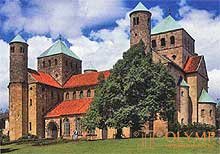
Aesthetics of the Renaissance grew out of the aesthetics and art of the Middle Ages. Medieval aesthetics are deeply theological, all basic aesthetic concepts are completed in God. For the aesthetics of the early Middle Ages, the influence of Aurelius Augustine is characteristic (354-430). He perfectly felt the beauty of the earthly, sensual world, but at the same time, already being a Christian, he was aware that visible beauty is a completely different quality than divine beauty. Augustine drew attention to the ratio of the beautiful and the ugly. beauty  for him, always identified with the form. The form of all beauty in Augustine was unity. The concept of unity, which came to him from Neo-Platonism, to replace his passion for maniah action, became the basis of his aesthetics. In addition to unity, Augustine associated proportionality and order with the concept of beauty. Augustine drew attention to such an aesthetic problem as the distinction between the visual and audiovisual arts (the essay “On Music”). He owns an interesting doctrine of rhythm - one of the important aesthetic categories.
for him, always identified with the form. The form of all beauty in Augustine was unity. The concept of unity, which came to him from Neo-Platonism, to replace his passion for maniah action, became the basis of his aesthetics. In addition to unity, Augustine associated proportionality and order with the concept of beauty. Augustine drew attention to such an aesthetic problem as the distinction between the visual and audiovisual arts (the essay “On Music”). He owns an interesting doctrine of rhythm - one of the important aesthetic categories.
I was interested in Augustine and such a problem as aesthetic perception, in particular the human perception of the beautiful. Here he paid attention to the sensual and intellectual 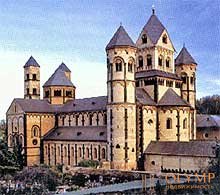 perception. In addition to Augustine in the Middle Ages, aesthetic themes to some extent related to Boethius Antiony Manlius Torquat Severin (480-524), John Scott Eriugen (c. 810-c. 877), Hugo St. Victorian (c. 1096-1141), Bernard Klervossky (1091-1153), founder of the scholastic method Pierre Abelard (1079-1142). In general, the idea of the early Middle Ages had a Neoplatonic orientation, in this regard, the main aesthetic categories were also comprehended. The art of the early Middle Ages as a whole corresponded to the theological spirit of the epoch and to the aesthetic views expressed by the church fathers. Art X-XI centuries. (VI-XII centuries.) Called the Romanesque. This is the first all-European (despite a number of not so fundamental national differences) artistic style.
perception. In addition to Augustine in the Middle Ages, aesthetic themes to some extent related to Boethius Antiony Manlius Torquat Severin (480-524), John Scott Eriugen (c. 810-c. 877), Hugo St. Victorian (c. 1096-1141), Bernard Klervossky (1091-1153), founder of the scholastic method Pierre Abelard (1079-1142). In general, the idea of the early Middle Ages had a Neoplatonic orientation, in this regard, the main aesthetic categories were also comprehended. The art of the early Middle Ages as a whole corresponded to the theological spirit of the epoch and to the aesthetic views expressed by the church fathers. Art X-XI centuries. (VI-XII centuries.) Called the Romanesque. This is the first all-European (despite a number of not so fundamental national differences) artistic style. 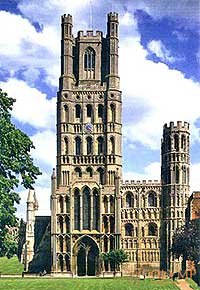 Before him, they talk about the art of the barbarian kingdoms, the art of the Empire (Carolingian, the art of the Ottonian empire (some researchers also refer these periods to the Romanesque art, then the time of the Romanesque style dates back to the 6th-12th centuries). ” Romanesque art ") was introduced by French archaeologists. Studying the buildings discovered from the excavations, they concluded that these buildings resemble buildings of ancient Rome. It is from here that the term" Romanesque "- the Roman name comes. The same name was distributed axis and the languages of some European nations, which originated from the Latin language.
Before him, they talk about the art of the barbarian kingdoms, the art of the Empire (Carolingian, the art of the Ottonian empire (some researchers also refer these periods to the Romanesque art, then the time of the Romanesque style dates back to the 6th-12th centuries). ” Romanesque art ") was introduced by French archaeologists. Studying the buildings discovered from the excavations, they concluded that these buildings resemble buildings of ancient Rome. It is from here that the term" Romanesque "- the Roman name comes. The same name was distributed axis and the languages of some European nations, which originated from the Latin language.
In the Romanesque style, the dominant (decisive) role was played by architecture. As if 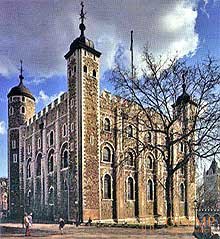 responding to the views of the church fathers — opponents of luxury, the buildings of this style (castles and temples) were strict and devoid of any excesses. Everything was subject to harsh reality. Stone buildings in the period of strife played the role of fortresses. These structures had massive walls, narrow windows, tall towers (to observe the approaching enemy). The main types of buildings were knight's castle, monastic ensemble, temple. Castles were built on high hills, river slopes, enclosed with a wall and a moat. The unassuming dwellings of the peasants contrasted with them. Castles were always built in places that were convenient for protection. Since the main concern was the strength and solidity of the building, their architecture was not distinguished by particular grace and taste. Typically, the locks consisted of wide round towers with notched platforms;
responding to the views of the church fathers — opponents of luxury, the buildings of this style (castles and temples) were strict and devoid of any excesses. Everything was subject to harsh reality. Stone buildings in the period of strife played the role of fortresses. These structures had massive walls, narrow windows, tall towers (to observe the approaching enemy). The main types of buildings were knight's castle, monastic ensemble, temple. Castles were built on high hills, river slopes, enclosed with a wall and a moat. The unassuming dwellings of the peasants contrasted with them. Castles were always built in places that were convenient for protection. Since the main concern was the strength and solidity of the building, their architecture was not distinguished by particular grace and taste. Typically, the locks consisted of wide round towers with notched platforms; 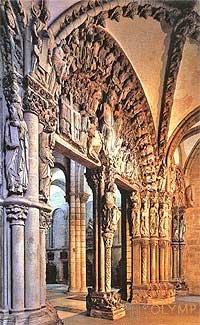 sometimes the towers were made quadrangular and huge stones were attached to them, which served for the belvederers (the belvedere is a tower with a view of the surroundings, or the name of some of the palace buildings). The towers were an integral part of every castle and were a special sign of the nobility. J. J. Rua, in his History of Chivalry, notes that when they wanted to emphasize the greatness of a nobleman, they said: “He has a tower”.
sometimes the towers were made quadrangular and huge stones were attached to them, which served for the belvederers (the belvedere is a tower with a view of the surroundings, or the name of some of the palace buildings). The towers were an integral part of every castle and were a special sign of the nobility. J. J. Rua, in his History of Chivalry, notes that when they wanted to emphasize the greatness of a nobleman, they said: “He has a tower”.
Jagged galleries connected the towers of the castle among themselves; they had a variety of windows. By their embrasures one could judge the thickness of the walls and the parapet. The windows were not only round and quadrangular, but also taking the form of eyes, ears or trefoil. The shutters were made of canvas. The entrance to the castle was defended by palisades, ditches, loopholes and embrasures in the walls. In the castles, everything inspired fear. It is not by chance that there are many legends about them. Rua notes that the castles suggest that the people of this pore liked everything massive and immense; that they had not the slightest taste for the graceful. Monastery Cathedral, along with the castle represented the Romanesque architecture. Romanesque cathedrals were also very massive. The monastery in these centuries was the focus of life. 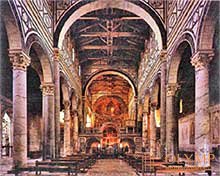 Craftsmen worked here, numerous pilgrims flocked here. Therefore, one of the main tasks of the architect of the Romanesque style was to create a repository of worshipers, and not the abode of the Divine, which was important in antiquity. The construction of the temple dates back to the early Christian temples (Byzantine basilica): 1. The central nave and two sides. 2. The transverse nave is a transept. 3. At the intersection of the central nave and the transept, a tower was put, and not a dome. 4. The western facade was decorated with front-facing towers. 5. The eastern part - the apse (decoration).
Craftsmen worked here, numerous pilgrims flocked here. Therefore, one of the main tasks of the architect of the Romanesque style was to create a repository of worshipers, and not the abode of the Divine, which was important in antiquity. The construction of the temple dates back to the early Christian temples (Byzantine basilica): 1. The central nave and two sides. 2. The transverse nave is a transept. 3. At the intersection of the central nave and the transept, a tower was put, and not a dome. 4. The western facade was decorated with front-facing towers. 5. The eastern part - the apse (decoration).
Romanesque temples amaze with power. There is nothing obscure about them. There is utmost simplicity and measure in everything. Looks sober view of the world. Temples, of course, create a sense of sublime, but heavy, overwhelming. Originally, the cathedrals were built with flat ceilings, and later they overlapped the interior with semicircular stone arches. To the vaults did not collapse, and built massive, heavy walls. Inside the temples were decorated with frescoes, outside with reliefs, often painted. The walls of temples and castles were decorated with woven carpets depicting scenes of non-religious content. For example, the carpet from the cathedral in Bayeux (XI century). He portrays the conquest of England by the Normans. 70 m long and 50 cm wide, this carpet serves as a kind of encyclopedia.
The central nave was distinguished by its large size. The temple was very bright (the light source is windows). The side aisles were also well lit. The interior emphasized the importance of the central nave. The parts of the cathedral were filled according to the hierarchy: behind the transept — the spirituality, then - the privileged part of the society, the rest - in the side naves.
The famous monuments of Romanesque architecture in France include the church of St. Peter and St. Paul in the Monastery of Cluny (1088-1131), the church of Saint-Lazare in Atene (1112-1132) - according to legend, the remains of Lazarus resurrected by Christ, the Church of Saint -Madlen in Everywhere (1120-1150) - according to legend, the relics of St. Mary Magdalene were kept in it; in Germany - the cathedral in Boris (1181-1234), the cathedral in Speyer (1030-1092-1106). The sculpture was associated with architecture. She did not have autonomy. Her purpose was to decorate, educate, amaze, educate (inspire religious ideas). The central idea of the sculpture was the idea of God. God appeared as a formidable judge, causing trembling. Pictures of the Apocalypse (one of the most popular themes of Romanesque art) also primarily inspire fear and awe. As, for example, the picture of the Last Judgment in the Cathedral of Saint-Lazar (1130–1140) in Otin. This is a relief, divided into several tiers. At the top are the angels with the righteous, at the bottom - the devils, attracting sinners. In the lower tier shows the souls waiting for the Court. The picture of weighing up bad and righteous deeds is remembered.
Romanesque sculpture conveyed excitement, confusion of images, the tragedy of feelings, detachment from all earthly. The spirit unconditionally suppressed physicality here. He is in eternal struggle with himself. In the era of Romanesque art, various types of painting developed: miniature, monumental painting; a stained glass window began to develop. In the art of miniature the book miniature was mainly presented during this period - the book was not conceived without illustrations. Received the development and monumental painting. Unfortunately, it is almost not preserved. It was mainly instructive in nature and was closely connected with architecture: played an important role in organizing the interior of the cathedral. The plots of Romanesque monumental painting were biblical.
Что бы оставить комментарий войдите
Комментарии (0)